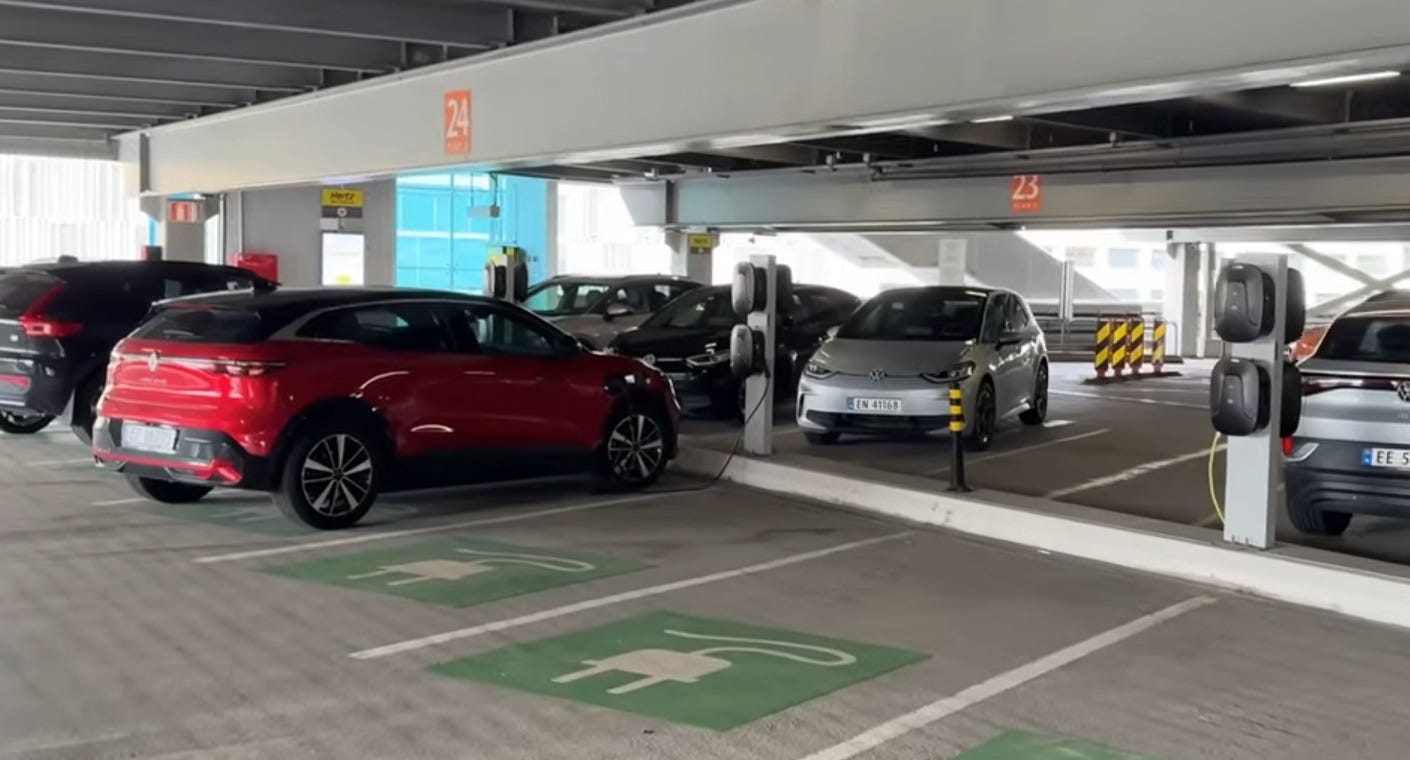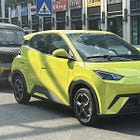Norway Has EVs Like America Has Guns. We Should Do A Norway!
EVs made up 97 percent of new car sales in Norway last month. We could do that, too!

I love bringing you kids some climate optimism on a Saturday, so let’s enjoy this Washington Post story from Friday (gift link) about how Norway has gone from having very few electric vehicles a decade or so ago, to becoming the first country with more EVs on the road than gas or diesel-powered vehicles, a landmark Norway just reached in September of last year. And as the article points out, EVs make up almost all new-car sales even in Norway’s northernmost region, Finnmark, where it’s pretty darn cold.
Norway’s progress toward decarbonizing its transportation sector — on the ground at least; airplanes are still stubbornly hard to decarbonize — pretty much invites a stream of examples and data, so the Post story indulges:
At the Skoda dealership in Alta, Finnmark’s largest city, salesman Orjan Dragland marveled at the transformation — how five years ago, every car on the showroom floor had a combustion engine, and now the inventory is all EVs.
In 2024, nearly 90 percent of new passenger cars sold in Norway were fully electric. Of the cars sold last month, the EV share was 97 percent.
By comparison, EVs last year accounted for 8 percent of new car sales in the United States, 13 percent in the euro zone and 27 percent in China.
We will attempt to hide our embarrassment for the US by asking, “Shouldn’t Euro be capitalized?” Maybe not, since it’s a currency, not the continent, fine.
Hooray For Activist Government
But if you really want a comparison that makes Norway shine compared to the US, it’s in the explanation that car dealer, Orjan Dragland gave asked what happened to completely change his new-car inventory: “What happened? The government happened.”
Quite simply, Norway’s government started taking action on climate back in the 1990s, when the rest of the world should have, too, which is a big part of why it’s getting close to becoming the first country in the world to reach 100 percent zero emissions new-car sales. Or very close.
To promote EVs, Norway offered big subsidies that made going electric an easy choice for consumers:
[The] government made EV purchases and leases exempt from a 25 percent value-added tax (VAT) — cutting thousands of dollars from the sticker prices — as well as from import and registration taxes.
Yay, Scandinavian social democracy helping people have nice things! The incentives have been so successful that a few have even been modified. VAT is now added to higher-priced EVs, because now that inexpensive EVs are everywhere, it’s silly to subsidize luxury cars. Little perks like free city parking and exemptions from tolls and ferry fares have also been eliminated or replaced with discounts.
All tolled (shame on me), many EVs in Norway are simply cheaper than gas cars, unlike in most of Europe and in the US. And yes, lots of Chinese EVs, which don’t face the 100 percent tariffs they do in the US and Canada, or the EU’s lower but still notable tariffs on Chinese EVs, which vary by brand from 17% up to 35%. Norway simply chose not to put any tariffs on Chinese EVs. Probably helps that there’s no domestic auto industry to protect, and that Norway wants full EV adoption as fast as possible. (Thing I had to look up to confirm: Norway isn’t on the euro or in the EU; it uses its good old kroner and likes it, by gum.)
Fun side note: While Tesla’s recently-facelifted Model Y (built in Germany) remains the top-selling EV model in Norway, Tesla has lost overall market share there because of Elon Musk’s personal toxicity, not to mention its stagnant vehicle line and technology. But mostly, it’s because there are so many good, high-quality competitors from European and Chinese manufacturers. (When Norway set out to transition to EVs, it attempted to build an EV industry of its own, but that failed. All cars and trucks are imported, regardless of powertrain.)
Charged Up, Ready To Go
In addition to the vehicle discount, Norway also went all-in on building a charging network that serves drivers in the cities and on the highways. Most drivers charge at home, and people living in apartments have a “right to charge,” meaning that if renters want to install EV chargers, landlords and apartment boards can’t say no, although the renters still have to buy the chargers like homeowners do. Cities have lots of level-2 slow chargers in parking garages and streetside, most of which use the “bring your own cable” model to reduce vandalism and maintenance costs. In addition, there’s plentiful fast charging for travelers; WaPo notes that the “longest distance between two fast-charging stations in Finnmark is about 80 miles,” and that on major roads, Norway is well ahead of the EU target of having fast chargers every 60 kilometers (37 miles).
Most of the charging network was heavily subsidized by the government, but now that EVs are nearly everywhere, nearly all new charging stations since 2022 have been built by private operators. To keep expanding the transition of trucking to electric, Norway continues to subsidize charging stations for heavy-duty vehicles.
Yeah, I know. They put thought into it and didn’t elect a cranky toddler who sought to knock it all down. That helps a lot!
You don’t have to watch the whole thing, but we did get a kick out of this recent car nerd video on EVs in Norway, 80 percent of which seems to be the narrator walking through parking lots and charging stations in Bergen, Norway’s second-largest city, and marveling at all the different EVs and plug-in hybrids.
How To Pay For It: Oil Revenue For Clean Energy, Not Billionaires
Norway’s goal is to become carbon neutral by 2030, which may be a bit of a polite fiction. It’s a matter of where you’re measuring the carbon: if you’re talking about emissions inside the country, then absolutely, Norway is rapidly greening its vehicle fleet, its homes and offices, and even industry. But the big driver of Norway’s domestic clean energy transition is the revenue from its massive oil and gas reserves, which make it Europe’s largest producer of both. As the Post explains,
Norway has invested its fossil fuel profits into what has become the world’s largest sovereign wealth fund, a nest egg worth $1.7 trillion. Returns from that fund help cover government expenses, which in turn makes it easier to accommodate climate-friendly tax exemptions.
The Post barely touches on it, but EV transition has also been made easier by lucky geography: just under 89 percent of its electricity comes from hydroelectric power, with wind making up nearly all the rest. Legacy fossil fuel plants made up only about 1.6 percent of the remaining energy mix. Not surprisingly given how far north Norway is, solar is only a teensy part of the mix, just .2 percent.
In addition to keeping all those EVs humming, all that clean electricity is keeping Norwegians warm and comfortable without burning oil or gas, because two-thirds of homes there have replaced older energy-hungry resistance heaters with far more efficient heat pumps. Those electric heaters were actually part of an earlier transition away from heating homes with fossil fuels, in response to the 1973 oil crisis. Again, that’s smart government policy: Norway heavily taxed oil and gas for home heating, making electric heaters, and then heat pumps, the more attractive choice. The government also funded training programs for workers to install heat pumps, creating a workforce that the US just plain lacks so far. Those Norwegians! It’s like the government there thinks things through and sticks with long term plans that make sense!
Needless to say, the Post story’s comments are full of climate deniers calling Norway hypocritical for funding its green revolution with dirty oil, shame on them. But then, those are the same people who call you a hypocrite if you’re calling for clean energy but don’t live in a cave.
The fact is, while the world transitions to clean energy, we’re still gonna use oil, and far better Norway uses its top revenue source to secure its own energy transition, so that it’ll be ready when the rest of the world catches up and nobody’s buying vast quantities of oil and gas. And switching an entire nation’s car fleet off fossil fuels — it will take a decade or more for older vehicles to reach the end of their useful lives — will definitely cut emissions greatly, a net gain for the world’s carbon budget. Honestly, other countries should be doing the same, and some already are, using carbon taxes. Funding the energy transition with revenue from oil isn’t hypocrisy, it’s using money from a currently necessary evil to make it possible to get rid of that evil.
How replicable is Norway’s success for the rest of the world? Obviously, it helps to have all that hydro, but rapid rollouts of wind, solar, and storage will produce similarly abundant clean power. And as energy wonk Rostad Sæther of the SINTEF research institute pointed out to the Post, the world’s EV market is now mature enough that countries can focus more on building charging infrastructure and greening their grids, instead of just creating demand for EVs.
Sure does help not to elect a fascist, too.
[WaPo (gift link) / Low Carbon Power / Guardian / WaPo (another gift link)]
Yr Wonkette is funded entirely by reader donations. If you can, please become a paid subscriber, or help recharge our batteries with a one-time donation!






OT: Huge night at the club. Batched an olive oil infused gardinier dirty martini for the oyster bar and thank God, it came out tasty. First time I’ve done commercial mixology for a crowd, not just the single glasses I write for Wonkette. I’m proud and excited and tired and happy.
>> How replicable is Norway’s success for the rest of the world? Obviously, it helps to have all that hydro, but rapid rollouts of wind, solar, and storage will produce similarly abundant clean power. <<
I'm optimistic that the tech is there for the majority of countries to have strong domestic renewable energy production. Obviously hydro was more mature in 1990 than solar, wind, tidal, etc. But most countries has SOME valuable energy production possibilities now that solar & wind are mature, storage is stumbling towards maturity like a cranky adolescent taking the PSATs, and tidal is, well, okay, tidal is still tidal, but maybe one of these days they'll hit on something that's cost effective and doesn't instantly corrode in salt water.
The plasma drilling for widespread geothermal is interesting, but Imma wait & see on that one.